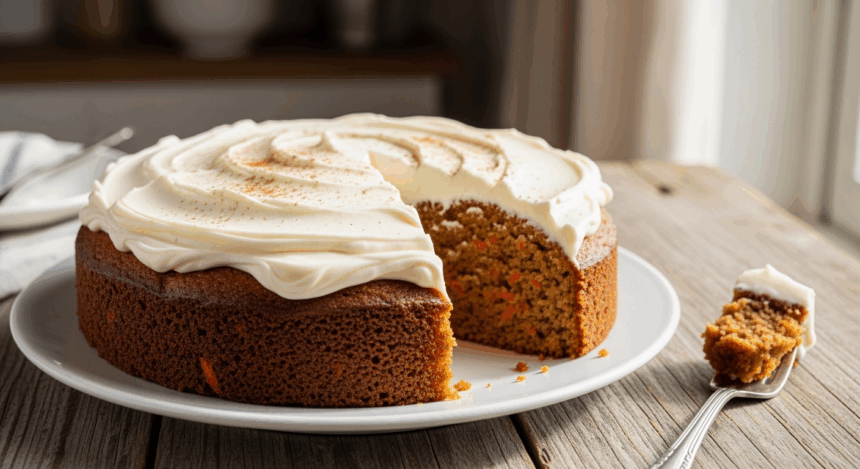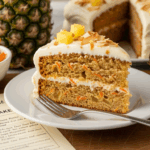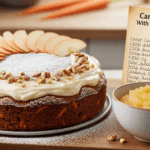Let’s be honest – carrot cake is basically salad with frosting, which means it’s practically health food, right? If you’ve ever needed a legitimate excuse to eat cake for breakfast (who doesn’t?), this carrot-packed masterpiece with its crown of tangy cream cheese frosting is your golden ticket. Grab your grater and let’s turn some vegetables into dessert magic!
Why This Recipe is Awesome
First off, this carrot cake is virtually impossible to mess up. Seriously, it’s like the golden retriever of cakes—friendly, forgiving, and everybody loves it. Unlike those temperamental soufflés that collapse if you breathe wrong, this cake actually improves if you’re a little rough with it.
Plus, you get to smugly tell people you’re “eating your vegetables” while devouring something that tastes like a hug feels. And that cream cheese frosting? It’s the kind of topping that makes you scrape the bowl with your finger when nobody’s looking (or even when they are—no judgment here).
Ingredients You’ll Need
For the cake:
- 2 cups all-purpose flour (the regular boring stuff, nothing fancy)
- 2 cups granulated sugar (because vegetables need friends)
- 2 teaspoons baking soda (the fizzy stuff, not the powder)
- 2 teaspoons ground cinnamon (more if you’re a cinnamon enthusiast)
- 1 teaspoon salt (to keep the sweetness in check)
- 4 large eggs (chicken-produced, not dinosaur)
- 1½ cups vegetable oil (yes, that much—this isn’t diet food, people)
- 3 cups grated carrots (approximately 4-5 carrots, or whatever your arm can handle grating)
- 1 cup chopped walnuts or pecans (optional for the nut-friendly folks)
- 1 teaspoon vanilla extract (the real stuff, not that imitation nonsense)
For the life-changing frosting:
- 8 oz cream cheese, softened (left out so long you forgot about it? Perfect!)
- ½ cup unsalted butter, softened (same deal)
- 4 cups powdered sugar (yes, FOUR cups—embrace the sugar coma)
- 1 teaspoon vanilla extract (again, the real deal)
- Pinch of salt (trust me on this one)
Step-by-Step Instructions
- Prep your workspace. Preheat your oven to 350°F (175°C). Grease and flour two 9-inch round cake pans, or be a modern human and use parchment paper.
- Mix the dry ingredients. In a large bowl, whisk together flour, sugar, baking soda, cinnamon, and salt. Make it look like you know what you’re doing with a confident wrist flick.
- Deal with the wet team. In another bowl, beat eggs and oil together until they look somewhat unified. Add vanilla. This is not the time to be gentle—beat those eggs like they owe you money.
- Create the union. Gradually mix the wet ingredients into the dry ingredients. The batter will be thicker than you expect, but thinner than peanut butter. It’s an identity crisis in a bowl.
- Add the star players. Fold in those grated carrots and nuts (if using). “Fold” means “stir gently” for anyone who thought we were making origami.
- Divide and conquer. Pour the batter evenly between your prepared pans. Use a spatula to get every last bit—this isn’t the time for waste.
- Bake until done-ish. About 30-35 minutes, or until a toothpick inserted in the center comes out mostly clean. If your toothpick looks like it went mud wrestling, give it a few more minutes.
- Cool your jets. Let the cakes cool in the pans for 10 minutes, then flip them onto a wire rack to cool completely. Patience, grasshopper—frosting a warm cake is a disaster waiting to happen.
- Make the frosting. Beat cream cheese and butter together until fluffy and cooperative. Add vanilla and salt, then gradually add powdered sugar until it reaches a spreadable consistency that makes you want to face-plant into the bowl.
- Assemble your masterpiece. Place one cake layer on a plate, spread a generous layer of frosting, top with the second cake, then frost the top and sides. Get artistic if you want, or just slather it on—either way, it’ll be demolished quickly.
Common Mistakes to Avoid
Grating your fingers along with the carrots. Those little orange guys can be slippery! Use the large holes on your grater and keep those fingertips intact. Nobody wants a “special ingredient” situation.
Overmixing the batter. This isn’t a cardio workout. Mix until just combined unless you’re aiming for a carrot-flavored brick.
Frosting a warm cake. Unless your goal is a cream cheese slip-and-slide, wait until the cake is completely cool. I mean COMPLETELY. Not just “eh, seems cool enough”—that’s how frosting disasters happen, people.
Refrigerating the cake immediately after frosting. Let it set up at room temperature for a bit. Rushing this relationship will only end in tears (yours, not the cake’s).
Alternatives & Substitutions
Oil options: Not into vegetable oil? Canola works great, or go fancy with melted coconut oil for a subtle tropical vibe. Applesauce can replace half the oil if you’re trying to be “healthy,” but let’s not kid ourselves about what we’re making here.
Flour flexibility: You can swap up to half the all-purpose flour with whole wheat if you want to feel virtuous. It’ll be slightly denser, but hey, more fiber!
Add-ins: Raisins, crushed pineapple, or shredded coconut can join the party at about ½ cup each. FYI, the raisin addition is controversial—prepare for strong opinions from your guests.
Spice it up: Add ½ teaspoon of nutmeg or ginger if you’re feeling adventurous. Or don’t. I’m a recipe, not a cop.
FAQ (Frequently Asked Questions)
Can I make this as a sheet cake instead?
Absolutely! Use a 9×13 inch pan and bake for about 35-40 minutes. Less architectural stress, same delicious result.
How do I store this masterpiece?
Once frosted, this cake needs to chill in the fridge because of the cream cheese. It’ll stay good for about 5 days, but let’s be real—it won’t last that long.
Can I make this ahead of time?
You bet! The unfrosted cake layers can be wrapped in plastic and stored at room temperature overnight, or frozen for up to a month. The frosting can be refrigerated for up to 3 days—just let it come to room temperature before attempting to spread it.
Is carrot cake actually healthy?
Is the moon made of cheese? No. But it has carrots in it, which is more vegetables than most desserts can claim. Let’s call it “healthier than some alternatives” and move on with our lives.
My carrots turned green in the batter! Am I going to die?
Nope! Sometimes the baking soda reacts with the carrots and creates a slight green tinge. It’s just chemistry having a laugh and is totally safe to eat. Think of it as bonus St. Patrick’s Day flair.
Final Thoughts
Congratulations! You’ve just created a carrot cake that would make bunnies jealous and grandmothers proud. Whether you’re serving it at a fancy dinner party or eating it straight from the pan at midnight (we’ve all been there), this cake delivers serious comfort food vibes with just enough vegetable content to quieten your inner health critic.
Remember, baking is part science, part art, and part throwing caution to the wind. If your cake doesn’t look Instagram-perfect, who cares? It’s going to taste amazing, and that’s what matters. Now go slice yourself a piece—you’ve earned it just by reading this far. And maybe, just maybe, count it as your vegetable serving for the day.



